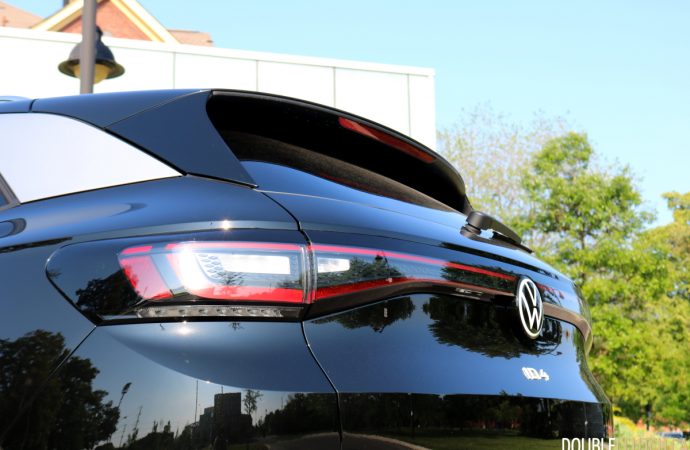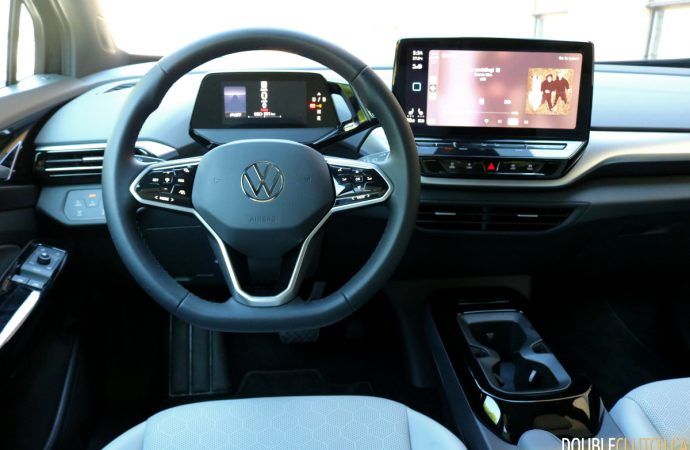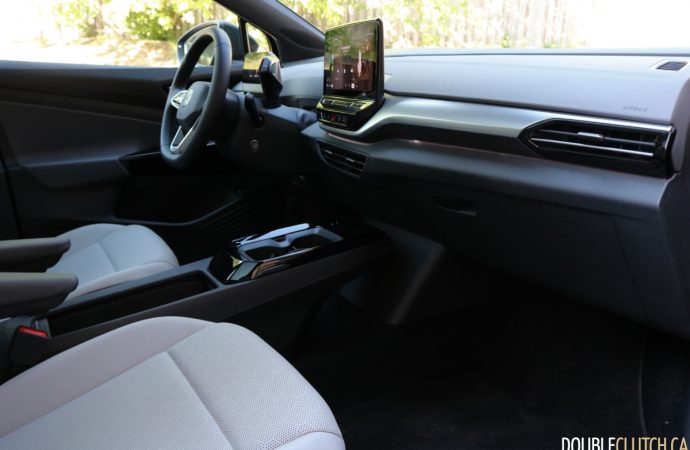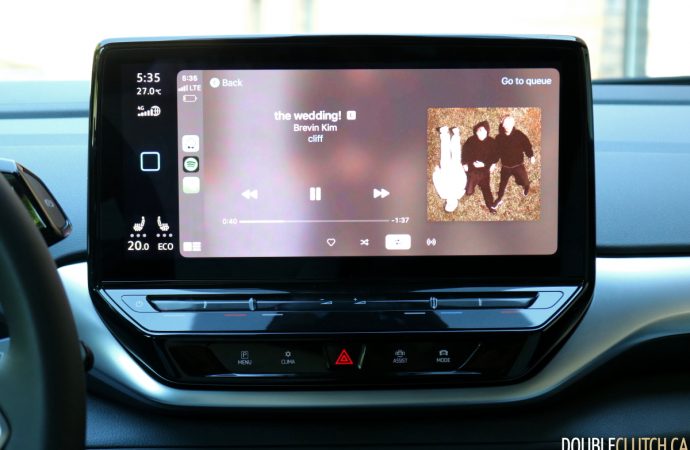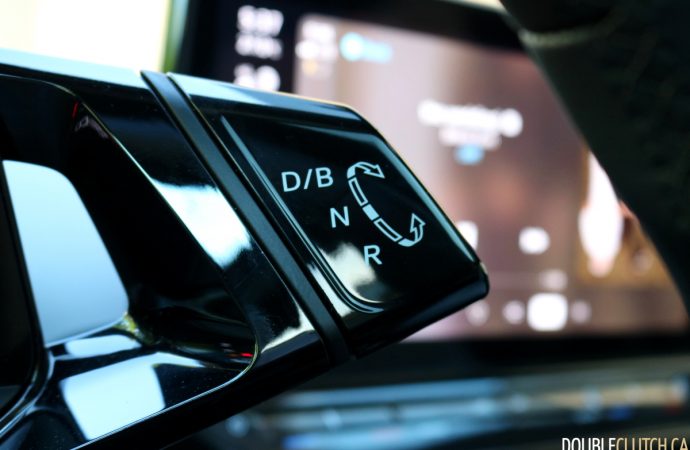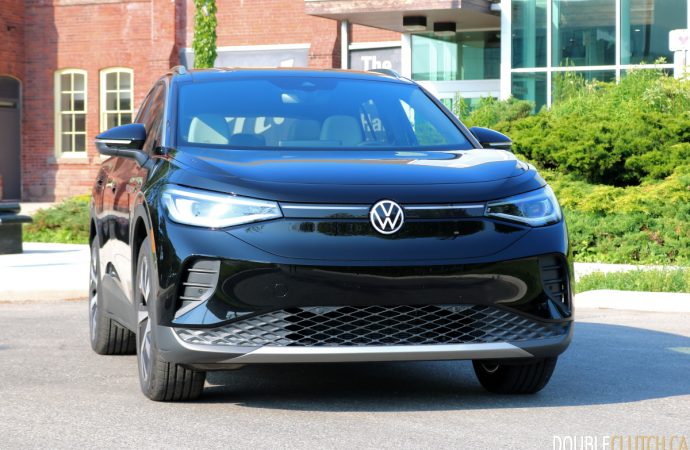TORONTO, ONTARIO – Dieselgate effectively killed any enthusiasm North America had for diesel-powered passenger cars, but diesel isn’t the only alternative method of powering cars. So then, how about electricity? Welcome, everyone, to the first dedicated electric car Wolfsburg’s made available to North America. The 2022 Volkswagen ID.4.
At first glance, there’s definitely a hint of Apple in the ID.4’s soft, minimalist lines. While many EVs have shrunk their frontal area and adopted bulbous silhouettes, the ID.4 keeps things smooth yet taut with fantastic proportions. The greenhouse is shorter than the wheel wells and adopts a more traditional silhouette than the Ford Mustang Mach-E and the Tesla Model Y. The front fascia is handsomely anchored by confident vents and a neat cross-hatch lower grille and the rear fascia uses unpainted plastic in a rather practical manner to reduce visual mass.
Said unpainted plastic comes all the way up to the hatch opening, so there’s no paint to scratch when loading and unloading cargo. Full-width lighting treatments on both ends emphasize visual width, further shrugging off the actual height of the ID.4. It’s a design that just works without any gimmicky futuristic bravado. That’s all saved for the interior.
To say that the ID.4’s interior controls are non-traditional would be an understatement. Nigh-on everything control from the headlamp switch to the stereo volume is capacitive touch. While this sounds like an absolute nightmare, it really isn’t that bad due to the ‘set it and forget it’ nature of modern car controls. The headlamps are automatic, as is the climate control. Need to lower the volume? Thankfully, there’s enough space on the slider to operate it in a nuanced manner. It seems intimidating and alien at first, but it’s really easy to get used to.
Ditto the electronic shifter, mounted on the side of the digital gauge cluster. Twist it forward to go forward, twist it backward to go backward and press the button on the side to put the ID.4 in park. This Bop-It-inspired shifter also comes with a neat party trick. Because the ID.4 has no engine to start, a start button isn’t strictly necessary. By using the occupancy sensor already embedded in the seat and the keyless start system, Volkswagen’s made it so that ID.4 drivers only need to put their foot on the brake pedal and select a gear in order to take off.
That’s not to say that the ID.4’s interior tech is flawless, though. Pressing what looks like the heated seat icons on the infotainment screen opens up the climate control sub-menu and only then can the heated seats be manually turned on. It’s a minor annoyance, but still a present one for Canadians. A more major annoyance is the presence of only two window switches on the driver’s door to operate four windows. How on earth does that work?
Surprise, the text that says ‘REAR’ above the two window switches is a capacitive-touch switch. Tap it, and the window switches control the rear windows. While it’s likely cheaper to manufacture than four separate window switches, you get the sense that Volkswagen reinvented the wheel here just to run itself over.
The rest of the ID.4’s interior is less controversial than the on-board tech. In fact, the rest of the interior is brilliant. Each front occupant has their own centre armrest and the centre console is absolutely chock-full of cubbies and cupholders and charging ports.
In terms of power, the big headline for the ID.4 is that the all-wheel-drive version does the nought to one hundred dash in the high five second range. But what about our rear-wheel-drive test car? Is it still quick? In the grand scheme of things, yes. While 201 horsepower in a fairly heavy car isn’t groundbreaking, instant torque means that it’s about as quick as an old VR6 GTI. However, there is no immediate neck-snap when you punch the skinny pedal off the lights.
Volkswagen has taken great steps to make the ID.4 feel normal on the road, including doling out initial torque gradually for low-speed smoothness. In addition, one-pedal driving isn’t an available setting and the fairly low level of regenerative braking makes the brake pedal easy to modulate for those not used to EVs.
This isn’t a bad thing though. Familiarity often breeds fondness and if current drivers of gasoline-powered cars are to switch to electric, easing into that electric feel will likely make that process easier. Besides, only speaking about acceleration is underselling what the ID.4’s really like on the road. For starters, it’s insanely quiet. Volkswagen’s always been a master of tight panel gaps and great seals to keep road and wind noise out, and the ID.4’s lack of an engine makes this all the more apparent.
Secondly, it’s very comfortable. Potholes, frost heaves, expansion joints and railway tracks are all smothered by remarkably composed suspension that makes the ID.4 feel much lighter than it is. This is aided by fantastic seats and driving position. The front chairs are supportive in all the right places and the steering wheel and seats have an unusually great range of adjustment.
Moving to about town driving, the rear-wheel-drive ID.4’s turning circle is genuinely remarkable, mostly because the front wheels can turn unencumbered by engine bay space restraints or front axles. Visibility is superb and the side mirrors offer a genuinely wide view. It’s an easy car to maneuver about. In terms of range, Volkswagen’s rated the ID.4 at 400 kilometres of range, but has done so in traditional German conservatism.
In the real world, we saw a minimum of 450 kilometres and a maximum of almost 500 kilometres in real-world driving. That’s genuinely excellent and we’re curious as to where the all-wheel-drive model will fall. Also worth noting is incredible energy efficiency. We saw around 18.4 KWh/100km which exceeds the efficiency we’ve seen from the Ford Mustang Mach-E and Kia Soul EV by a vast margin.
Optioning up an ID.4 is really quite simple in Canada. After choosing either rear-wheel-drive or all-wheel-drive (an extra $5,000), there’s only one major options group. It’s called the Statement Package and it costs a whopping eight thousand dollars. What does it include? Power massaging leatherette seats, premium headlamps, a panoramic glass roof, 20-inch wheels, silver accents around the side windows, a power liftgate, a 12-inch touchscreen for the infotainment system and 30-colour adjustable ambient lighting.
All very nice stuff, but none of it is really a requirement. You still get heated seats, a heated steering wheel, a 10-inch infotainment system, 19-inch wheels and 10-colour ambient lighting on the basic model, along with dual-zone climate control, parking sensors and a fully-stocked suite of active driver assists on the base model. Truthfully, that’s the big news. A $44,995 ID.4 is still a well-equipped, comfortable vehicle with just as much range as more expensive models. More importantly, it feels like a car more than it does an electric car. While other automakers are chasing bigger screens, more minimalist interior design and eco-fashion exteriors, Volkswagen has made a compact crossover from the ground up that just so happens to be electric.
As a result, it feels vastly more sophisticated than the Kia Soul EV, Kia Niro EV and Hyundai Kona EV. It may not have the sporting demeanour of a Ford Mustang Mach-E, but that’ll likely help it find wider appeal. It’s also much roomier than a Nissan Leaf and looks infinitely dorky than a Chevrolet Bolt EUV. All good stuff, and that’s before we even get to the price. At $44,995, it’s less expensive than almost the entire field.
A Mustang Mach-E is over five grand more expensive, the base-model Soul EV and Niro EV don’t offer competitive range and while the Hyundai Kona EV is only a few dollars more expensive, the base model doesn’t come with a heat pump which is fairly critical for Canadian winters. While the upcoming 2022 Chevrolet Bolt will be less expensive than the ID.4, it won’t offer the enticing option of all-wheel-drive and since it isn’t a clean-sheet design, I’m still not convinced that it will have the sophistication of the ID.4.
The 2022 Volkswagen ID.4 is proof that the future is bright. It’s comfortable, practical, well-priced, nice to drive and features very little compromise. No wonder pre-orders are so strong. Canadian availability will be limited at first to a few select dealers in Ontario, Quebec and British Columbia, but widespread availability will come as soon as the Chattanooga plant comes online to supplant Wolfsburg production. Canadian deliveries start this autumn, so it’ll only be a short wait until customers can enjoy their own ID.4s.


